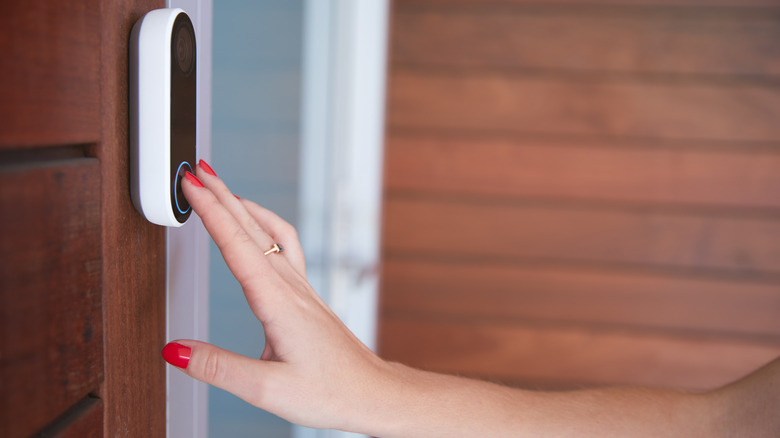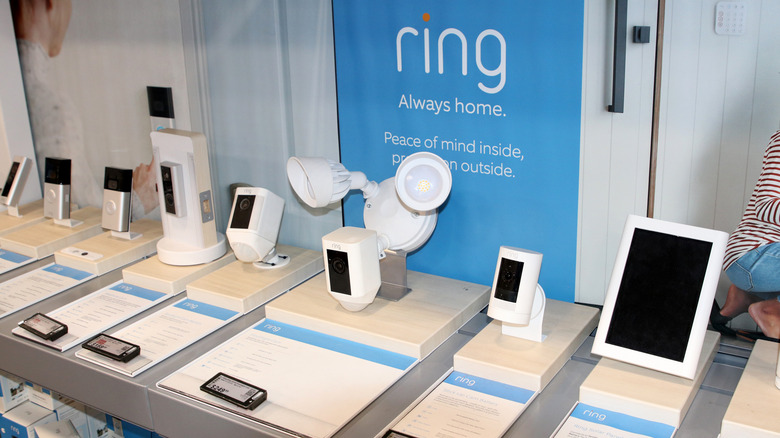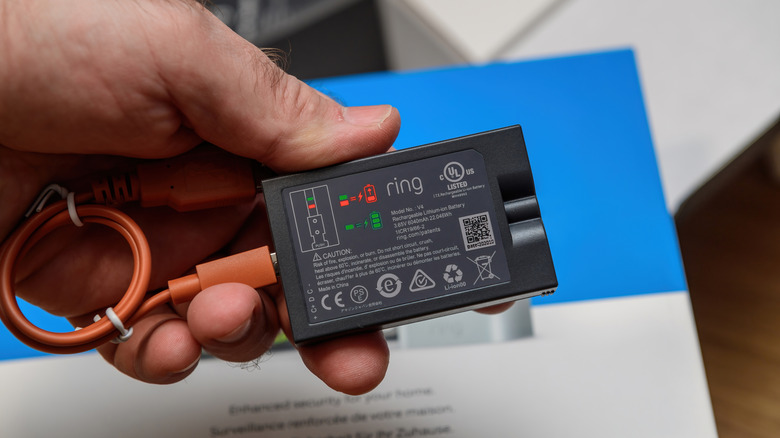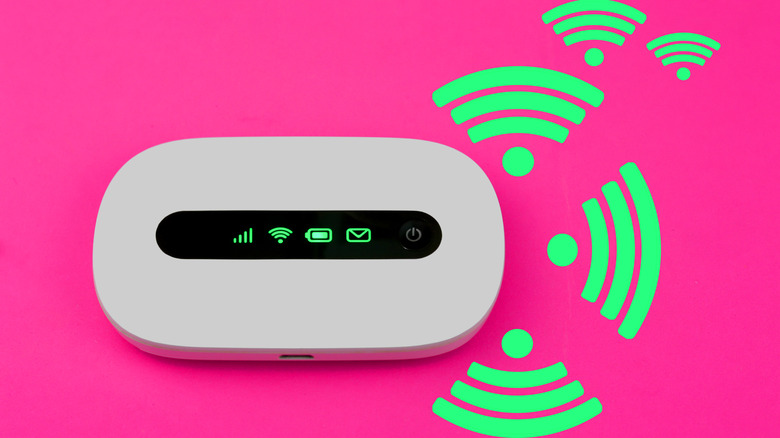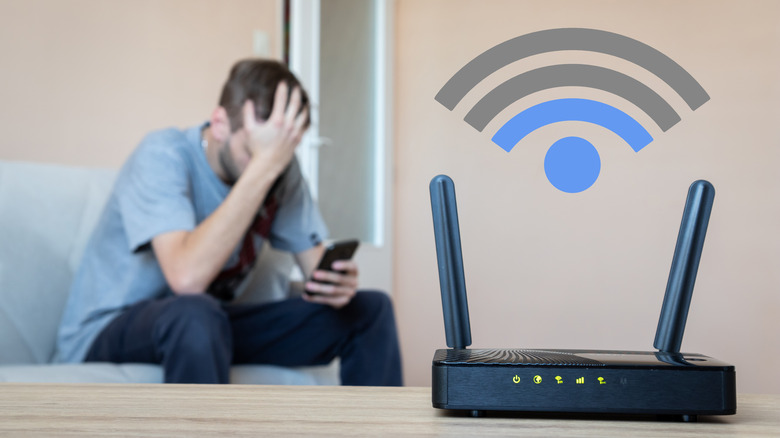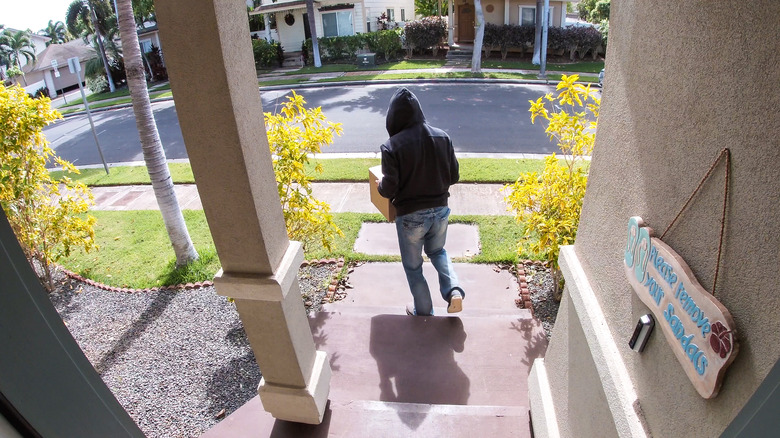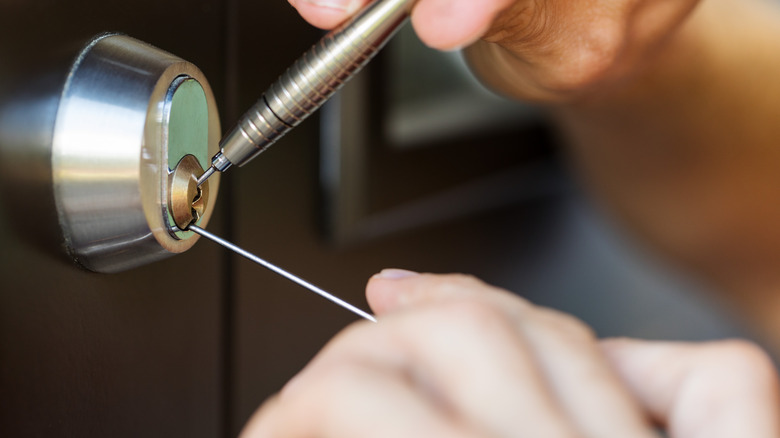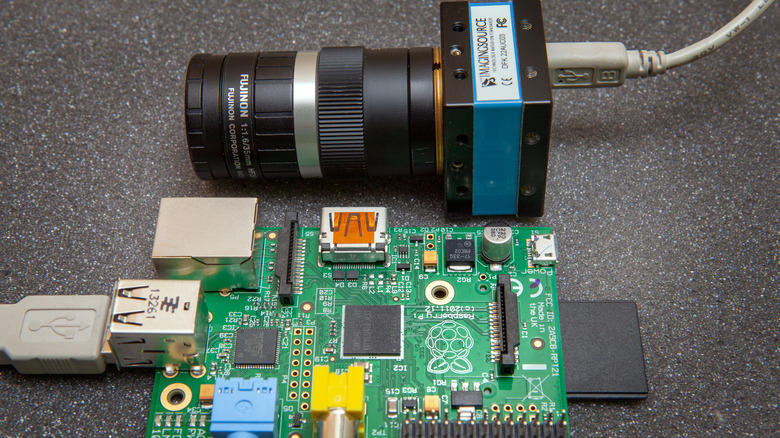The Hidden Downsides To Doorbell Cameras
Americans have long had a love/hate relationship with their smart home technologies. As a group, these Internet of Things (IoT) devices have been prone to security holes and technical hiccups, difficult to integrate with related products, and more expensive than seems justifiable. Eric Murrell of the International Association of Certified Home Inspectors adds battery life problems and just plain being difficult to control. At the same time, we love individual products, whether they have these failings or not. There's no better example than video doorbells: we love them, whatever their failings.
How much do we love them? Analysts say that the $1.59 billion 2020 video doorbell market will experience a 17.3% compound annual growth rate and estimates the market at $5.74 billion by 2028 (via Emergen Research). By comparison, that's the annual value of U.S. florists and something called modular chillers, which should be (but doesn't appear to be) choose-your-own-adventure horror stories. If this doesn't sound pretty huge, keep in mind that this market didn't exist a decade ago.
Let's have a look at the downsides and make sure all that love is justified... keeping in mind that, when it comes to tech gadgets, sometimes the love justifies itself.
It's only cheaper if you directly compare it to... well, nothing
One knock on video doorbells has long been that they are unduly expensive little devices. Digital Trends points out that security cameras have superior video coverage and installation options, but video doorbells are cheaper in absolute terms. A cheap doorbell camera will cost you less than $100, while the cheapest camera-and-DVR setup is $200+. But if the features that matter to you are found in security cameras instead, perhaps that is the better value. Typically, security cameras have a better quality picture with better motion distance and night viewing distance.
The 4th-generation Ring doorbell sells for around $220, and nearly $500 when bundled with audio or security system components. But the cheapest Ring sells for $52 ($82 when paired with an Echo Dot). This compares favorably with the Wyze, Blink and Eufy offerings... and is even competitive with most the budget brands. In absolute terms, that's also not bad. The Home Depot sells several traditional doorbell setups for around $30. It's not a pure apples-to-apples comparison because the traditional doorbell kits can come with a chime and transformer. But it tells you that you're paying about $20 for the smart home functionality (video, two-way audio, motion detection, etc.), which doesn't sound unreasonable.
Try telling your grandfather that your doorbell requires a subscription
The expense doesn't stop when you check out at Amazon, either. Vice says that techies fed up with having to subscribe to everything have mounted a bit of a self-hosting revolution, in which they provide their own infrastructure (yes, you can self-host a cloud server). This is a reaction to subscription fees, the almost inevitable "betrayal" when a service is shut down (rendering your product useless), and the security issues inherent in handing your data over to big tech or storing it in the cloud.
There is some movement toward making self-hosting easier, including offerings from Eufy and Arlo (via AndroidCentral) that store your video locally. Google offers one as well, the Nest Doorbell Battery, but note that the files can only be stored locally for a limited time. Self-hosting purists will, understandably, ask why access to their own video is time-limited.
HelloTech says that most video doorbells have a subscription-free level featuring reduced functionality, often leaving out features like saving video (Ring, for example) or very limited video history (Nest). Other features only available with subscription plans can include the creation of activity zones, emergency calling, animated previews, and many more. Subscription plans vary from about $30 per year to $100 annually (via Homeneer).
Every possible technical problem is truly possible
Like many smart home devices, video doorbells suffer from a number of common technical issues created by the cheapness of the devices, the wild variability in home network environments, the relative competence of the installer (usually the homeowner), and other factors. These include everything from crashing to simply not working to starting fires.
If "starting fires" caught your attention, note that the Ring doorbell recall involving fires was mostly a matter of installer error... the wrong screws were used (via NBC News). With less dramatic failures that don't result in a recall, you're likely to hear a lot of explanations that put blame or responsibility on the shoulders of the user.
Digital Trends describes six common video doorbell problems, along with 16 possible solutions. At least 12 of these are user error (from incorrect app settings to insufficient network resources). Compatibility issues and app failures make up the rest of the issues, and with these, correction is a matter of luck. If resetting the device or updating the app doesn't work, you'll likely be waiting for a fix to roll out... of which there is no guarantee. And many compatibility issues, especially those known at product launch, will never be fixed.
Showdown: wiring problems versus battery power problems
One problem that affects nearly everyone is the problem of power... either getting the doorbell wired correctly, or dealing with batteries in wireless models. (Here we mean wireless power, not wireless communication technology like Wi-Fi.) Power issues explain a number of other doorbell failures, according to Ring support, such as crashes, dropped Wi-Fi, freezing, poor motion detection, and others.
Power challenges come with the IoT territory, where low-power battery-operated devices are the norm. Doorbell cameras present a bit of a challenge here, because being constantly on (and, for many models, constantly recording video) can deplete a battery in no time. Check battery life in product reviews. Try turning off motion alerts (which probably become annoying anyway) and improving your Wi-Fi signal. If you have a Ring device, consider buying the Ring Chime Pro accessory, which comes with a Wi-Fi extender and should help battery life (via The Big Tech Question)
Wired doorbell power problems are more vexing. There are so many opportunities for failure that it's difficult to boil down the solutions. Likely culprits include failed transformers, incorrect wiring, old or damaged low-voltage wiring within your walls, etc. If these issues sound daunting or mysterious, your best bet might be to hire an electrician.
Your mobile hotspot is expensive and slow, but at least it doesn't work
One occasional technical issue that arises is that some video doorbells falter when connected to mobile hotspots. Some work fine with these hotspots, with a few caveats. Obviously, your cell connection can be more temperamental than a hard-wired internet access line. They also tend to chew through your data quickly, which can be an issue if you're on a limited plan, says Yvette Griffith of Smart Home Point.
Some tips: Check your Wi-Fi security settings to make sure they're compatible with your doorbell. Make sure the Wi-Fi name (SSID) and password contain no special characters. Ensure that the hotspot is running at 2.4 GHz and not 5. Try turning on bridging mode on your router, if it exists. And speaking of bridging, you can attempt to bridge your mobile hotspot to your local network (via WikiHow).
Some problems can't be resolved. If you're in a situation where accessing a hotspot requires you to accept terms of service, your doorbell will probably not be able to navigate that requirement. It's also possible that connection problems are the result of your mobile carrier's settings, which can prevent certain devices from connecting (via Smart Home Owl). If you suspect this is the case, contact your mobile provider. Finally, note that you can't usually have a mobile hotspot and Wi-Fi running at the same time on your smartphone.
Mom, the doorbell is using all the Wi-Fi again!
If you have a doorbell camera, every time it streams video you'll probably be putting your Wi-Fi through a bit of stress. By itself, the video doorbell should be no problem; your home network can probably handle it just fine. But if you use it in conjunction with such other bandwidth-intensive services as security cameras or media servers, or if you have a lot of people streaming on your network, you could start to see bandwidth problems.
Video doorbells use as much as 50 gigs of bandwidth per month, according to Smart Home Point. This is influenced by camera settings like motion capture sensitivity, which dictate how often video is recorded or streamed. You can mitigate the issue to some extent by a number of means. Try transferring some of your smart home load to other networking technologies like ZigBee and Z-Wave to keep it off your Wi-Fi. If you have a lot of old devices that once had Wi-Fi access but you no longer need that functionality, change your Wi-Fi password without updating the devices; usually, they'll quietly drop off your network. Try using a different Wi-Fi channel for your video doorbell and keeping your router updated (which is always a good idea anyway).
Your security device is vulnerable to being hacked
If there are two things everyone knows about doorbell cameras, it's that they can stop porch pirates and they are easy to hack, putting your network at risk and exposing video of your family to some evil group or other. These "facts" might or might not be true today in any broad sense, but the hackability complaint has certainly been true in the past of a pretty wide range of brands. As recently as 2021, Consumer Reports tested 11 cameras and found significant security vulnerabilities among four from the brands Eufy, Bosma and Nooie. CR also reported in February of 2022 that five DIY security systems (including ones from Ring, SimpliSafe and Eufy) were vulnerable to hacker attacks via jamming, which disables the security systems and could also be effective against wireless video doorbells.
So what does it mean to have your video doorbell hacked? Not-for-profit British consumer advocate Which? summarizes the dangers like this: hackers can take control of your doorbell; they can use it as an entry point to attack and compromise other devices on your network; and they can conscript your doorbell in a "botnet," a large network of compromised IoT devices attacking servers and other internet devices. These are all problems, but the second puts your other devices at risk, and can cause problems from compromised privacy to identity theft.
Exactly how does video doorbell security go so sideways?
Which? investigated 11 video doorbells in 2020 and found that all of them contained security vulnerabilities. Major issues included exposing unencrypted Wi-Fi logins, storing data without encryption, vulnerability to known security threats, and collecting more data than necessary for the camera to fully function. Encryption addresses a lot of security issues, but note that end-to-end encryption is not possible in every circumstance, and so turning it on will inevitably cause a doorbell to turn off other desirable services, says Ring CTO Josh Roth.
One example of an insecure device, the Victure VD300, sent unencrypted Wi-Fi passwords to Chinese servers; and these can be intercepted and read anywhere along the way. There are a number of ways IoT devices like doorbell cameras can be protected, including changing default passwords (Consumer Reports suggests using a password manager and turning on two-factor authentication), always using secure communications to ensure that data is encrypted, rejecting custom encryption schemes rather than industry standard systems, protection of onboard code and memory, using microcontrollers without reset buttons (which allow attackers to bypass any custom protections), and updating device firmware (via Electropages). But note that firmware update mechanisms can, themselves, introduce security vulnerabilities to fake firmware updates.
Privacy concerns, or being proactively paranoid
Having fun yet? This one is where even the most trusting consumers start to lose their patience. Some privacy concerns aren't due to any particular vulnerability in video doorbells. For example, a former domestic partner secretly gaining and keeping access to doorbell and security cameras is surely a privacy concern, but one that doesn't exist due to any flaws in the devices. And accounts shared with trusted friends and family can be hacked themselves, creating a security and privacy issue for you.
And it's not just your privacy at risk. Your neighbors and visitors can also have a privacy stake in your doorbell-use decisions. These cameras can record audio from as much as 30 feet away, far enough to create privacy concerns for anyone on many suburban sidewalks (via Consumer Reports).
Ring devices now include a Control Center dashboard, which users can use to improve default privacy settings (for example, to track who has access to the feeds and videos), says Consumer Reports. One universal (and universally unpopular) option is to enable end-to-end encryption, in which your videos are securely encrypted throughout every step of their existence. This is a great option because of the thing people dislike about it: enabling end-to-end encryption necessarily disables other features that introduce vulnerabilities, including Alexa integration and video sharing.
Pre-roll isn't time travel, it's 24-hour surveillance
As we noted, doorbell cameras record audio, too, and can often be configured to record it continually. But, says Brian Fagioli of BetaNews, doorbell cameras with pre-roll features (which give you video starting around four seconds before a recording is triggered) can only work if the device is constantly recording video, 24 hours a day. This is similar to the way Alexa must constantly listen in order to respond (via Wirecutter). But, unlike Alexa, Ring doorbells actually save these recordings, and for subscribers that means storage in the cloud.
While this is obviously a potential privacy concern to some extent, most consumers want as much video as possible and seem to be more disappointed with the limitations rather than the fact of this recording, as evidenced by such forum posts as "Does Ring Now Offer 24/7 Recordings? If Not, Why Not?!," "Does Ring Offer 24/7 Recording? (Ring PROMISED This In 2018...)," and "Why does my Ring Doorbell not record everything?"
The risk with encrypted video is probably minimal, and most doorbell video is encrypted. But around-the-clock video recording will sound like surveillance to some, so it's worth considering.
These things can make you paranoid
More and more tech journalists — and possibly normal people as well — are convinced that video doorbells make people paranoid. That is, because of the camera the user becomes convinced they are more at risk of crime than they actually are. Grand claims by companies like Ring have touted research leading consumers to believe they are effectively protecting themselves using doorbell cameras. In the most prominent case of this strategy, Ring claimed that installing a small number of doorbells reduced burglaries in one community by 55% But the MIT Technology Review analyzed public data from the same general area and for the same period, and found a net increase in burglaries. Subsequent informal studies in West Valley City, Utah, and Newark, New Jersey, claimed similar benefits for Ring doorbells but, upon review, seem to indicate that the doorbells actually correspond to higher rates of burglary. (The data is ultimately insufficient to support either conclusion.)
Security company Garage Shield describes this as an overload of information that causes constant worry and an unnecessary obsession with monitoring. Garage Shield's back-of-envelope estimates predict that 99% of the time, the doorbells are alerting you to something that is not a problem.
Others have found much the same result. Journalist Max Read describes subscribing to Ring's online community as "terrifically addictive, a wildly engaging hodgepodge of voyeurism, suspicion, unease, and mystery" and said the alerts made him paranoid and hypervigilant (via New York Magazine).
Paranoid, But Still Less Safe
Not being as safe as you feel is a misunderstanding, but being actually made less safe by video doorbells is an entirely different level of concern. The idea is that the comfort your doorbell gives you can cause you to be lax in other areas (an extreme example would be failing to lock your doors), says Garage Shield.
Combine this with false alarms, which can numb you to real alerts, and you might not keep close watch on your surroundings. This relates to the concept of situational awareness, a decision-making framework that involves being accurately aware of all elements of the current environment as possible, in order to extrapolate likely or possible future events. It has been adopted by the self-defense industry as shorthand for staying on the lookout, and it is undermined if your doorbell makes you feel so comfortable you are not really paying attention to your surroundings.
It's not all psychological. Michael Hiltzik, writing for the Los Angeles Times, observes that video doorbells arguably make us less secure from cyberattacks, compromise our rights via deals with police, and expose us to eavesdropping, stalking and harassment via technical flaws. Given the evidence for all of these, it certainly seems like the devices can make you less safe in certain circumstances.
Trusting the police to trust you
Ring doorbells in particular have long been associated with a close working relationship with law enforcement. This sounds like, and usually is, a good thing. We have these devices to deter and punish crime, after all. But these programs can pressure or even compel you to comply with police in ways you wouldn't normally. A Policing Project audit found a number of issues with Ring's typical police outreach and recommended more than 100 changes, which privacy and civil rights activists say are still insufficient, according to Consumer Reports.
It's not as if the doorbells always work to the advantage of police. ZDNet reports that video doorbells have been used to monitor police activity while attempting to serve a warrant, but doesn't indicate how this is substantively different from the use of security cameras or, for that matter, windows. Still, it's possible these devices are supporting criminal activities... much like phones, cars, and clothes can aid criminals.
In 2019, entrepreneur Declan McCullagh wrote for Reason magazine that requesting videos from users bypasses the search warrant process. The California Law Review questioned many aspects of Ring's relationship with police and police interactions with doorbell owners, arguing that it threatens the Fourth Amendment, that Amazon might be acting as a de facto police agent, and that much of it is constitutionally questionable.
If all else fails, make your own and at least that failure will be all yours
One approach to solving many of these challenges is to roll your own doorbell camera setup. If you're up to the mild technical challenge, it's fairly straightforward and gives you absolute control over its functionality and security. Using a Raspberry Pi single-board computer or a microcontroller board like the ESP32, along with off-the-shelf smart home or video surveillance software, you can tailor functionality to more in the mode of door-answering than door-guarding, if your goal is to eliminate a paranoid obsession with camera feeds.
There are many approaches documented in how-to articles and videos across the Web. Make: has a Raspberry Pi-powered system that includes a doorbell cam and a smart lock, though if you're concerned about security you might shy away from systems that unlock your door, unless your coding chops are better than most companies'. A tutorial at Tom's Hardware shows you how to, using a Raspberry Pi, bypass the doorbell button entirely and detect the presence of a person using machine learning. Circuit Digest uses a simpler (and cheaper) approach with its doorbell camera based on an ESP32 microcontroller board.
Whether one can be expected to make a more secure device than international IoT vendors is another matter.
